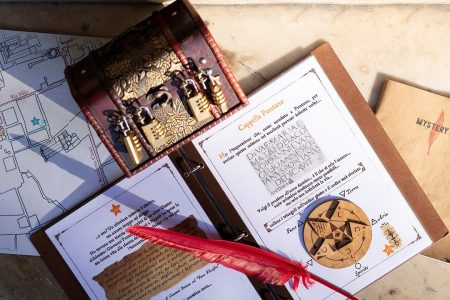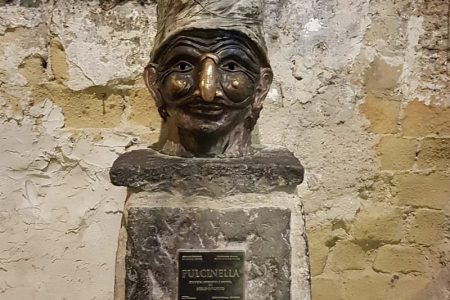Table of Contents
The historic center of Naples is the ideal place to fully understand Neapolitan culture and grasp the roots of a people who live by traditions and superstitions. In this picturesque area, some iconic and unforgettable places certainly do not go unnoticed, such as Jesus Square and the Monastery of St. Clare.
The former is perhaps one of the most famous squares in the Neapolitan capital, crossed by the famous Via Spaccanapoli which bisects the city. Instead, the Basilica of Santa Chiara is a splendid Franciscan complex with a centuries-old history that attracts thousands of tourists each year eager to see its cloisters. Come with us to discover these two incredible attractions set in the belly of Naples!
History and customs related to Jesus Square
Piazza del Gesù is one of the symbolic squares of Naples and owes its name to the eponymous church of the New Jesus overlooking the esplanade. It is located along the lower decumanus, and its central location places it very close to other places of interest such as Via Toledo, Piazza Monteoliveto, Piazza Dante, and Piazza San Domenico Maggiore.
In the center of the square is a large obelisk dedicated to the Immaculate Conception, while on the west side can be seen a number of noble buildings in the late Baroque style, including Palazzo Pignatelli di Monteleone and Palazzo Pandola. Whereas on the opposite side is an elegant medieval complex, the Church of the Poor Clares.
Front and side are two other churches, that of Gesù Nuovo and the Monastery of Santa Chiara. The Gesù Nuovo church was built on what was left of the Sanseverino Palace, and on its facade it displays a diamond-pointed ashlar, an emblem of Neapolitan Baroque.
Lorem ipsum dolor sit amet, consectetur adipiscing elit. Ut elit tellus, luctus nec ullamcorper mattis, pulvinar dapibus leo.
You might be interested
The Secret of the Immortals: private treasure hunt through the alleys of Naples
per person Book
Visit Naples in half a day: guided tour from Piazza Dante to Piazza del Gesù
per person Book
Instead, Santa Chiara is the most impressive Gothic-style church in Naples and contains inside the official burial ground of the Bourbon family and the rulers of the Kingdom of the Two Sicilies.
The centerpiece of Jesus Square is its obelisk, also known as the Immaculate Spire, commissioned by Jesuit Father Francesco Pepe from a design by Giuseppe Genoino. A full 22 meters tall, it was erected in 1750 in place of a statue of Philip V that was destroyed in 1707.
The obelisk is covered with splendid marble decorations, and on its top is a golden statue of the Immaculate Virgin. In fact, one of the main traditions associated with the square concerns December 8, the feast of the Immaculate Conception, when the mayor honors Our Lady with a bouquet of roses placed at her feet by firefighters. The ritual usually takes place around noon and is a very emotional moment for citizens.
However, this ceremony belongs not to the clergy, but to the city, according to an agreement sanctioned in 1818 between Pope Pius VII and King Ferdinand I of Bourbon, as evidenced by the coat of arms on the gate protecting the base of the structure.
To visit Jesus Square we recommend this ghost tour in the historic center of Naples which takes off from that very area. You will have an unusual experience as you will go on a ghost hunt equipped with real paranormal phenomena equipment, and you will also be able to admire Piazza San Domenico Maggiore and the Pietrasanta Bell Tower.
Monastery of St. Clare: the jewel in the crown in the heart of Naples
The Monastery of Santa Chiata, known as the Basilica of St. Clare, is one of the main monastic and worship complexes in Naples. Its entrance is located along Via Benedetto Croce on the lower decumanus and then extends to the northeast side of Piazza del Gesù.
It is one of the most visited monuments in the center and takes the form of a large basilica in the Gothic-Angevin style. The monastery includes 4 cloisters, the archaeological excavations and several exhibition rooms of the Opera Museum, which instead includes the nuns' choir, a refectory and the sacristy.
The Monastery of St. Clare was built at the request of Robert of Anjou and his wife Sancia of Majorca who commissioned the project from the architect Gagliardo Primario. Work began in 1310 and was completed in 1328. Important artists of the time such as Giotto and Tino di Camaino worked on its interior.
In 1590 it was the seat of the monastery Antonio da Patti, and between 1742 and 1796 it was renovated with new Baroque forms by Dominic Vaccaro and Gaetano Buonocore. Instead, Ferdinand Fuga was responsible for the addition of the marble floor in 1762.
Unfortunately, a bombing in 1943 caused an extensive two-day fire that destroyed part of the church and some of the frescoes. In 1944, reconstruction work began and continued until 1953, when the complex was finally reopened to the public.
In 1995, the Opera Museum with the aim of reconstructing and passing on the history of this important building. On display inside are archaeological artifacts found under the basilica after World War II, reliquaries, sacred objects and other sculptural elements recovered after the 1943 fire.
To learn more about the monastery we suggest this tour of esoteric Naples that will reveal to you the mysteries and alchemical secrets between Santa Chiara, Jesus Square and Devil's Palace. What are you waiting for? Run and book your ticket.



0 Comments